| 兄弟会需要你的帮助! 本条目包含未翻译内容。您可以帮助刺客信条维基来 翻译这个条目。 |
- “Even when your kind appears to triumph... Still we rise again. And do you know why? It is because the Order is born of a realization. We require no creed. No indoctrination by desperate old men. All we need is that the world be as it is. And THIS is why the Templars will never be destroyed.”
- ―Haytham Kenway to the Assassin Ratonhnhaké:ton about the Templars, 1781.[来源]
The Templar Order, also known as the Order of the Knights Templar, is a secret organization dedicated to ensuring the creation of a New World Order through force and control. Throughout the 12th to early 14th century, the Templars acted as a knightly military order, and by the mid 20th century had become a corporate giant after the foundation of Abstergo Industries.
Throughout history, the Templars have manipulated individuals and events to further their goals, notably during the Roman era, the Crusades, the Renaissance and modern times. Their endeavours often clashed with the ideologies of their sworn enemies, the Assassin Order.
Because of this difference in ideology, the Templars became involved in a covert war against the Assassins, spanning centuries, with their opposition's motivating belief being that mankind should always have the ability to choose; to have the freedom of liberty, even if it meant accepting that humanity would always be flawed in their ways.
History
Ancient world
Prehistory
The origins of the Templar Order remain a mystery; it is believed that the Templars have existed since the dawn of humanity, or at least since humanity claimed its freedom from the First Civilization.[1]
Sometime after the Toba catastrophe of 75000 BCE, Cain, the son of Adam and Eve, murdered his brother Abel to acquire an Apple of Eden. It is speculated that Cain was a Templar or that he at least inspired or played an active role in its foundation. The mark of Cain became the emblem of the Order, and some of the earliest Templars considered themselves to be the Children of Cain.[1]
Early history
- “Officially, the Order of the Knights Templar was created in 1129, but we have endured, under various appellations, since well before the 12th century.”
- ―A transcript from one of the Abstergo Files, 2012.[来源]
Some of the earliest known precursors to the Knights Templar trace back to the Old Kingdom of Egypt, when the Pharaoh Smenkhkare founded the Order of the Ancients, an organization that would later transform into the Templar Order.[2] In 1335 BCE, Smenkhkare succeeded the Pharaoh Akhenaten, from whom he acquired an Apple of Eden. Smenkhkare in turn eventually passed it down to his successor.[3]
Templar history can next be traced back to the 5th century BCE, when what would become known as the Templar Order aided Darius I, fourth king of the Achaemenid Empire, in overthrowing the usurper and ascending the throne of Persia. These proto-Templars aided his son and successor, Xerxes I, in his suppressions of revolts in Egypt and Babylon and conquering of most of Greece.[1] Xerxes I was killed by the proto-Assassin Darius in 465 BCE, the first recorded usage of the Hidden Blade.[4]
During the 4th century BCE, the proto-Templars entrusted Alexander the Great with one of the Staves of Eden, which Alexander used to become one of the most successful conquerors in history.[1] However, this also made him a target of the proto-Assassins, as he was poisoned by the Babylonian proto-Assassin Iltani in 323 BCE.[4]
In the 3rd century BCE, the proto-Templars supported Qin Shi Huang, who united China and became its first Emperor under the Qin Dynasty.[1] Qin Shi Huang's rule quickly became tyrannical, and he was assassinated by the Chinese proto-Assassin Wei Yu.[4]
Middle Ages
Formation as a military order
- “For the first time in our long history, our Order was made public, but its truest and noblest agenda remained secret.”
- ―A transcript from one of the Abstergo Files, 2012.[来源]
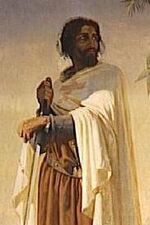
Grand Master Hugues de Payens
In 1118, the French abbot Bernard de Clairvaux realized that the Order needed the Church as its ally. He sent nine of his most trusted men to the Holy Land in search of Solomon's Temple, and upon their return, reinvented the Order alongside Grand Master Hugues de Payens, creating the Latin Rule. The Order of the Knights Templar, as they would henceforth be known, was officially recognized and confirmed during the Council of Troyes in 1129. For the first time the Order made itself public, but their real goals and purpose remained a secret.[5]
In the wake of the First Crusade, the Crusader army managed to maintain a presence in the Holy Land. The Knights Templar, as well as the Knights Hospitalier, were among the military orders that heped maintain their foothold, until Saladin managed to unite much of the Islamic world.[1] Later, during the Third Crusade, the Knights Templar again spread out to the Holy Land. During the Siege of Acre, Grand Master Gerard de Ridefort was captured and beheaded by Saladin, at which point the position was left vacant until 1191.[1] Lord Basilisk, a high-ranking Templar, stepped in to become the de facto leader during 1190.[6]
Struggle for the Apple of Eden
- “You know not the things in which you meddle, Assassin. I spare you only that you may return to your Master, and deliver a message. The Holy Land is lost to him and his. He should flee now while he has the chance. Stay, and all of you will die.”
- ―Robert de Sable to Altaïr Ibn-La'Ahad, 1191.[来源]
In 1191, Robert de Sable took up the mantle of Grand Master. Under de Sable's leadership, eight notable participants in the Third Crusade from both the Crusader and Saracen sides secretly joined the Templar Order. The Grand Master and these eight men joined forces with Al Mualim to find one of the Apples of Eden, and discovered the artifact to be located in an ancient vault beneath the remains of Solomon's Temple.[7]

De Sable and the Templars at Masyaf
In order to obtain the artifact for himself, Al Mualim betrayed the Templars and sent Altaïr Ibn-La'Ahad and Malik and Kadar Al-Sayf to retrieve it. Simultaneously, de Sable strived to gain the object as well, and Altaïr attempted to assassinate the Grand Master inside the vault. The Assassin failed, though Malik was able to take the Apple back their headquarters in Masyaf during his escape. The Templars followed in pursuit, and laid siege to Masyaf's village. Arriving at the Masyaf citadel, they were routed by Altaïr, who unleashed a trap of falling tree trunks on the Templars.[7]
In response, Al Mualim sent Altaïr on a quest to take down the nine Templars. In the months of July and September, Altaïr travelled to the cities of Damascus, Acre and Jerusalem to take down each of his targets. The Grand Master, realizing the threat to his life, assigned Maria Thorpe to pose as him at the funeral of one of the killed targets, Majd Addin, while de Sable himself rode to Arsuf to attempt to unite the Crusaders and Saracens against the Assassins. After having fallen for the trap, Altaïr confronted the Grand Master while the latter was consulting with King Richard I of England, who allowed the two to engage in a duel. De Sable fell to the Assassin's blade, but revealed Al Mualim's betrayal to Altaïr, who then proceeded to kill his Mentor.[7]
Post-Third Crusade activity
- “Our so-called King meets with his Templar advisers in London. Shall we pay them a visit?”
- ―The Assassin Robert Fitzwalter to his supporters, c. 1215.[来源]
Outside of their presence in the Crusades, the Knights Templar continued to hold sway over positions of power. King Richard I's brother and successor, John, was one such target, being under the influence of his Templar advisors. The Assassin Robert Fitzwalter rose up against the King, gaining support from the English barons and sparking the First Barons' War in 1215.[8]
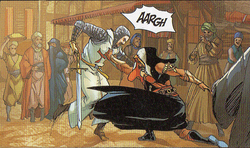
A Templar Knight killed by the Assassin
In 1250, the Knights Templar in Egypt saw an opportunity to retrieve a Precursor artifact called the Scepter of Aset, when the artifact was being brought to the rebelling Mamluks by an Egyptian Assassin. However, their attempt to obtain the artifact resulted in failure.[9]
By the 1260s, Alexander Nevsky, Grand Prince of Vladimir and a Templar ally, was using his alliance with the Golden Horde, a division of the Mongol Empire, to protect medieval Russia from becoming a target of the Mongols. However, his connection to the Templars instead made him a target of the Mongolian Assassins, and he was killed by Nergüi in 1263.[8]
Fall of the Knights Templar
- “Pope Clement, hear me! Before this year is out, you will answer for your crimes before God almighty. And you, King Philip, no punishment is too heinous for the great evil you have inflicted upon the Temple. I curse you! Curse you to the thirteenth generation of your blood! You shall be cursed!”
- ―Jacques de Molay to Pope Clement V and King Philip IV, 1314.[来源]
In 1307, the Mentor of the French Assassins, Guillaume de Nogaret, councillor to King Philip IV, used his influence in the French court to turn the King and Pope Clement V against the Knights Templar. They were branded as heretics, and Philip ordered the arrest of all members of their Order. On 13 October of that year, Esquieu de Floyrac led a force of Assassins disguised as mercenaries in an attack on their Temple in Paris. Realizing the danger they were placed in, Grand Master Jacques de Molay ordered his advisor to hide their Codex Pater Intellectus and Sword of Eden in their vault.[10]

Jacques de Molay arrested
Finding the artifacts stolen by Master Assassin Thomas de Carneillon, the advisor went into pursuit of the Assassin and retrieved them. However, after hiding the objects in the vault, de Molay was captured by the Assassins, and the advisor was killed by de Carneillon. The Grand Master was held in captivity, and after standing trial, was burned at the stake on 18 March 1314 alongside Geoffroi de Charney.[10]
Shortly before his death, de Molay realized that the Order could no longer function as a public organization. He selected nine of his most trusted men and sent them out into the world, armed with the knowledge of the Ancients, to continue the Templars' plans outside of the public eye.[5]
Rebirth as a secret order
- “History teaches they were disbanded nearly 200 years ago in France. Only they weren't. Merely pushed underground where they continued their nefarious work.”
- ―Mario Auditore about the Templars, 1477.[来源]
In 1321, the Templars made their continued existence known to the Assassins when they killed Dante Alighieri, a prominent member of the Italian Assassins, in an effort to retrieve the Codex of Altaïr Ibn-La'Ahad. They hired a group of pirates to follow the Assassin who would later be known as Domenico Auditore to the Otranto harbor to obtain the book, but Domenico had already scattered and hid its pages. By 1324, the Templars had killed Domenico Auditore's father and Marco Polo, other prominent members of the Italian Brotherhood.[4]
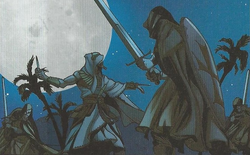
Templars fighting Numa at Karnak
In 1340, Egyptian Templars stole the Scepter of Aset from the court of the reigning Bahri dynasty, and smuggled the artifact to their hideout at Karnak.[9] On 7 June 1341, Sultan Al-Nasir Muhammad himself was killed by the Templar agent Leila. Not too long afterwards, the Scepter was retrieved by the Assassin Numa Al'Khamsin. After Leila's capture, she wound up sharing a cell with Numa.[11]
The two escaped, though after the Templars lured Numa into a trap, the Assassin was killed by Leila. Retrieving the Ankh-shaped box containing the Scepter from the Assassin's apprentice, Ali Al-Ghrabe, Leila discovered it to be empty upon wanting to give the artifact to the Emirs of Egypt. The Templar agent discovered the Scepter to be hidden in a well near Edfu Temple, but fell while trying to retrieve it, and became amnesiac, having no recollection of her allegiance to the Templars.[12]
Several years later, in 1348, a Templar group called the Brothers of the Cross travelled through Europe offering protection from the Black Death; secretly, they were looking for the Ankh, a Precursor artifact. Two years later, the Brothers of the Cross vanished, alongside the Assassin Lukas Zurburg.[13]
At the end of the 14th century, the Knights Templar in Scotland started an expedition to the New World, led by Henry Sinclair and James Gunn. The expedition landed in North America on 2 June 1398.[14]
Four years later, the Templars played a role in the ascension of the Yongle Emperor. Using their influence in the Imperial court, they managed to have Yongle initiate a purge of the Assassins in Eastern China, resulting in the deaths of thousands of citizens, including the Assassin leader Fang Xiaoru. In 1424, the Yongle Emperor was killed by a survivor of the purge, the Assassin Li Tong.[13]
The Templars also maintained a presence during the Hundred Years' War. After discovering that the French warrior Jeanne d'Arc was in possession of a Sword of Eden, they orchestrated her capture and burning at the stake in order to obtain the artifact.[4]
During the middle of the 15th century, the Templars were engaged in a struggle with the Ottoman Empire, with the Templar Vlad the Impaler, the Prince of Wallachia, taking a center role in the conflict. In December 1476, Vlad was defeated by the Ottoman Assassin leader Ishak Pasha, and he was later killed by the Ottomans.[5]
Renaissance
Rise of the Italian Templars
- “I became Pope because it gave me ACCESS. It gave me POWER. Do you think I believe a single god-damned word of that ridiculous book? It's all lies and superstition. Just like every OTHER religious tract written over the past ten thousand years.”
- ―Rodrigo Borgia on his position as Pope Alexander VI, 1499.[来源]
In 1476, the cardinal Rodrigo Borgia became Grand Master of the Italian Templars.[15] However, under his leadership, the Templars lost sight of their true purpose of peace, instead meaning to take control of Italy out of a lust for power and greed; the Templars would later come to refer to this era as the "Dark Age of the Order".[1] With Rodrigo's supervision, the Templars orchestrated several conspiracies to dismantle the power of the Italian city-states,[4] the first of which was the successful assassination of Duke Galeazzo Maria Sforza of Milan on 26 December 1476,[16] followed by the execution of the Assassin Giovanni Auditore da Firenze and his sons Federico and Petruccio in Florence three days later.[4]
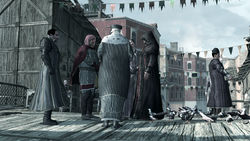
Venetian Templars meeting with Rodrigo
However, their attempt to kill Lorenzo de' Medici, the leader of Florence, on 26 April 1478 was thwarted by Giovanni's surviving son Ezio, who had taken up his father's Assassin mantle. Rodrigo shifted his attention to Venice instead, where the local Templars conspired to murder the reigning Doge, Giovanni Mocenigo. On 14 September 1485, Mocenigo's advisor, Carlo Grimaldi, poisoned the Doge, despite Ezio's attempt to thwart their plan. The Templars installed Marco Barbarigo as the next Doge, until his demise at Ezio's hands in February of 1486.[4]
In the meantime, in June of 1482, the Templar Cem, brother of Sultan Bayezid II of the Ottoman Empire, had hidden the Apple of Eden he retrieved from his father Mehmet II in the Templar Archive on Cyprus, unable to make it work, for the western Templars to find.[17] Rodrigo sent his subordinates to retrieve the artifact from Cyprus on 11 July 1486, acting on information from the pages of Altaïr's Codex. They brought the artifact to Cyprus in 1488, where it was stolen by Ezio and the Italian Assassins.[4] Having lost the Apple, Rodrigo focused on becoming a Papal candidate and bought the votes of his colleagues, desiring the power of the Church for himself.[18] In 1491, Rodrigo unsuccessfully attempted to thwart Christopher Columbus' voyage to the West Indies, wishing to keep North America a Templar secret.[19]
Spanish Inquisition
Fall of the Borgia family
- Cesare Borgia:“Forget the Pope, you answer only to me. Roma is the pillar that holds our entire enterprise aloft. She cannot waver. Which means neither can you.”
- Octavian de Valois:“What of il Vaticano (The Vatican)?”
- Cesare Borgia:“That tired old men's club? Play along for now, but soon we will have no need of them.”
- —Cesare Borgia to his generals, 1501.[来源]
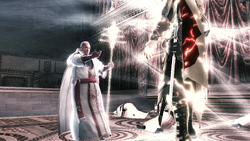
Pope Alexander VI using the Staff of Eden
Rodrigo Borgia became Pope Alexander VI on 11 August 1492, gaining access to the Papal Staff, a Staff of Eden, and the vault beneath the Vatican. On 28 December 1499, Rodrigo was confronted and defeated by Ezio at the entrance of the Vatican Vault, and after being spared,[4] instead wished to focus on maintaining the power the Templars wished to establish than conquering new ground.[20]
Despite Rodrigo's wish not take revenge on the Italian Assassins for their attack on Rome, his son Cesare Borgia laid siege to their headquarters of Monteriggioni on 2 December 1500, killing their leader Mario Auditore and taking the Apple of Eden. Cesare swiftly became the de facto leader of the Italian Templars, and their influence spread throughout most of Europe, reaching as far as the courts of King Louis XII of France, King Manuel I of Portugal, Queen Isabella I of Castile and King Henry VII of England. While Cesare dedicated his efforts to conquering other regions of Italy as Captain General of the Papal Armies, he placed their headquarters in Rome in charge of his generals Juan Borgia, Octavian de Valois and Micheletto Corella.[20]
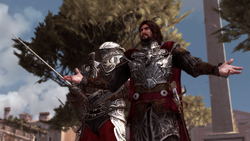
Cesare Borgia leading his Templar followers
The Assassins, led by Niccolò Machiavelli and Ezio, destroyed the Borgia's influence throughout the country, including the war machines their ally Leonardo da Vinci was forced to create for Cesare. In August 1503, Juan Borgia and Octavian de Valois were killed by Ezio, and Corella's attempt on the life of Pietro Rossi, the lover of Cesare's sister Lucrezia, was thwarted. Rodrigo, seeing his son as a threat, attempted to poison him, but was killed by Cesare instead. Without the power of the Church, Cesare's influence severely diminished, and he was captured on orders of Pope Julius II in December 1503.[20]
He escaped from imprisonment in the Castel Sant'Angelo soon afterwards, but was captured again and imprisoned in the Castillo de la Mota near Valencia, Spain. With help from Micheletto Corella, he escaped in 1506. After an attack by Ezio, Machiavelli and Leonardo decimated their forces near Valencia, Cesare betrayed and killed Micheletto. The Grand Master left for Navarre, seeking the support of his brother-in-law King John III.[21] While leading the Navarrese troops at the Siege of Viana in March of 1507 for John, Cesare was killed by Ezio Auditore, officially leaving the Italian Templars leaderless.[20]
Return of the Byzantine Templars
- “I am tired of all these pointless blood feuds that pit father against son, brother against brother. To achieve true peace, mankind must think and move as one body, with one master mind. The secrets in the Grand Temple will give us just that. And Altaïr will lead us there.”
- ―Prince Ahmet about his Templar goals, 1512.[来源]
In 1509, an earthquake struck Constantinople, the heart of the Ottoman Empire. In the wake of its destruction and the absence of Sultan Bayezid II, who was fighting with his son Selim over his succession, the Templars made their return to the city under the banner of the Byzantine Empire. Initially led by Manuel Palaiologos, their cause managed to gain various sympathizers who were disillusioned with the Ottomans. The Sultan's own son, Prince Ahmet,[5] whose uncle Cem was a Templar,[17] was among those tired by the division between man, and his sense of leadership and charisma allowed him to slip to the position of leader of the Byzantine Templars.[1]
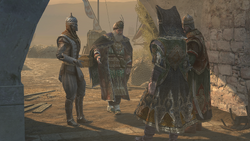
Shahkulu and Manuel making a deal with Tarik Barleti
Circa 1511, the Templars found the journal of Niccolò Polo, The Secret Crusade, and discovered the existence of the library of Altaïr Ibn-La'Ahad. While he would attend to matters in the empire, Ahmet placed Manuel in charge of an expedition to find the keys, five Memory Seals, needed to unlock the library in Masyaf, where Ahmet believed was the knowledge leading to the Grand Temple.[5]
Ahmet's confidante Hasan Pasha managed to find one underneath Topkapı Palace,[17] though their attempts to obtain the Memory Seals from the Yerebatan Cistern and Forum of the Ox were thwarted by Ezio Auditore, who had journeyed to the empire with the same goal of unlocking the library. In the process, Ezio thwarted the Templars' attempt to abduct Prince Suleiman, who would then be "rescued" by Ahmet, and killed Manuel Palaiologos and his right-hand Shahkulu at the Byzantine Templar headquarters in the underground city of Derinkuyu.[5]
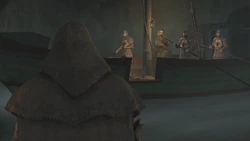
Ahmet threatening Ezio in Derinkuyu
After Ahmet ordered his Templars to abduct Ezio's romantic interest Sofia Sartor, during which the Ottoman Assassin leader Yusuf Tazim was killed, Ahmet offered to exchange Sofia for the five Masyaf keys, which Ezio had gathered. He obtained the keys from Ezio, and left Constantinople for Masyaf, with Ezio and Sofia in pursuit.[5]
Ezio and Ahmet fell off a cliff during their altercation, only to be saved by Ezio's parachute, and the prince was confronted by his brother Selim, returning from his victory over their father. To prevent his brother from laying claim to the Ottoman throne, Selim threw him off a nearby cliff, and the Templar leader plunged to his death, effectively dismantling the Templar presence in the empire.[5]
Reign of the Eight Tigers
- “China is just a piece of the prize. We will rule the world, and the box you so kindly presented us, will be yet another tool to achieve a time of peace.”
- ―Zhang Yong to Shao Jun during their final confrontation, 1532.[来源]
During the early 16th century, Zhang Yong, a member of the Eight Tigers, a group of powerful Chinese eunuchs in the court of the Zhengde Emperor, was recruited into the Templar Order. In 1510, the Eight Tigers' leader Liu Jin was accused of conspiring against the emperor, and Zhang Yong succeeded him following his execution. After the Emperor died heirless on 20 April 1521, the country was momentarily left in a state of chaos. During the search for a successor, the Eight Tigers used their influence to install their puppet Jiajing, Zhengde's nephew. In 1524, the Tigers used their new influence to initiate the Great Rites Controversy, a purge which led to the extermination of their enemies including the Assassins. They installed Yan Song as the public face of their administration, while they maintained their control and hunted for Precursor artifacts.[22]

Zhang Yong standing over Wang Yangming's body while holding the Precursor box
In 1526, the Assassins' leader Wang Yangming and his former student Shao Jun returned to China following their Brotherhood's decimation. After Jun allowed herself to be captured by the Tigers, they came to acquire the Precursor box from her. Over the course of the next few years, the Assassins hunted down the Eight Tigers, though Zhang Yong and Qiu Ju eventually counter-acted their enemies' attacks, resulting in the death of Wang Yangming and the near-capture of Shao Jun.[22]
By 1532, Zhang Yong was the only surviving Tiger and, in a final act of defiance against Shao Jun, planned to let the Mongol army of the Altan Khan through the gates of the Great Wall into China. The Assassin thwarted his plan, and killed the Templar on top of the Great Wall, decimating the Templars' hold over China.[22]
Expansion to Japan
- “These converts are our foothold in this country.”
- ―The Jesuit Alessandro Valignano about the Templars' influence in Japan.[来源]
After suffering multiple defeats at the hands of the Assassins during the first half of the 16th century, the Templars searched for new areas to expand their influence. Circa 1549, the Jesuit Francis Xavier turned his attention to Japan, seeing an opportunity to spread both Christianity and the Templar ideology. Landing in Japan in the middle of the Warring States era, the Templars struggled to gain a strong footing in the country, resolving instead to utilize the few native sympathizers they could find. After hearing of the Templars' presence in Japan, the Assassins quickly followed suit, finding allies among the ninja clans.[8]

Mochizuki Chiyome with her kunoichi
One of the Japanese Templars, the warlord Uesugi Kenshin, fought various battles with his rival Takeda Shingen, the owner of a Sword of Eden. Their rivalry ended when Shingen was assassinated in 1573 by the Tokugawa and the Assassins, and Kenshin himself was killed by the Assassin Hattori Hanzō in 1578. The Italian Templar and Jesuit Alessandro Valignano meanwhile maintained a presence in the country, continuing to gain converts and Templar recruits, forcing Francisco Cabral to resign his post as Superior of the Jesuit Mission when he found out about Valignano's Templar activities in the process.[8]
By the 1590s, the Templars had managed to recruit the kunoichi Mochizuki Chiyome, Shingen's spymaster, gaining a vast information network that helped spread their philosophy throughout Japan. However, she was also killed by the Assassin Hattori Hanzō, shortly before his own death in 1596 at the hand of Fūma Kotarō.[8]
Age of Imperialism
Salem witch trials
Search for the Observatory
- “For two decades now I have endeavored to locate this Observatory... a place rumoured to contain a tool of incredible utillity and power. [...] With this device, there would be no secrets among men. No lies. No trickery. Only justice. Pure justice.”
- ―Laureano de Torres y Ayala to his fellow Templars, 1715.[来源]
During the later part of the 17th century, the Templar Counsel had entrusted Laureano de Torres y Ayala, Grand Master of the Templar Order in the West Indies, with finding the Observatory, an ancient First Civilization complex with the power of monitoring the life of any individual. By 1673, Torres had managed to determine that the complex was linked to "Sages" – humans born with the genetic code and memories of Aita, the Observatory's architect. That year, Torres encountered a Sage known as Thom Kavanagh among Peter Beckford's employees, though the man was abducted by the Assassin leader Bahlam and kept out of the Templars' reach.[23]
Operations in North America
- “It could contain certain knowledge. Perhaps a weapon. Or something as yet unknown, unfathomable in its construction and purpose. It could be any of these things. Or none of them. [...] But of one thing I am certain: whatever waits behind those doors shall prove a great boon to us all.”
- ―Grand Master Reginald Birch of the British Rite talking about the Grand Temple, 1754.[来源]

The British Templars in their headquarters
By the 1730s, Grand Master Reginald Birch of the British Templars, the assistant of Edward Kenway, chose to preoccupy himself with finding First Civilization artifacts from across the world.[14] In so doing, he orchestrated Kenway's murder to retrieve his journal, from which he learned of the Grand Temple, located in the New World. He also took Kenway's son Haytham under his wing to teach him in the Templar ways.[24]
Birch employed Master Templar Lawrence Washington with operations in the New World, and started reaching out to Rites across the world for aid in procuring leads and artifacts. To the same extent, he sent John Harrison across the globe. The Templars' search failed to find any Precursor sites in the Orient and Lisbon, though they recruited William Johnson of the East India Company, the Spanish scientist Antonio de Ulloa and the Louisianan noblewoman Madeleine de L'Isle in the process, the latter of which was soon tasked with finding Precursor artifacts in Chichen Itza in Yucatán.[14]
In November 1751, Washington stole the Precursor box and manuscript from François Mackandal, Mentor of the Haitian Assassins. The Templars in North America soon faced opposition from the Colonial Assassins, as Shay Cormac assassinated Washington, Samuel Smith and James Wardrop to retrieve the artifacts.[14] Around the same time, Haytham Kenway retrieved the Grand Temple's key and was sent to Boston by Birch, where he established the Colonial Rite of the Templar Order. After Haytham killed his old rival Templar Edward Braddock in 1755, he was led to the Grand Temple by his ally Kaniehtí:io, but after realizing the key could not open its door, believed that it was not the Grand Temple's location.[25]
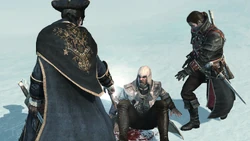
Haytham Kenway crippling the Mentor Achilles Davenport
The next year, Shay Cormac allied himself with the Templars to stop the Assassins from triggering more earthquakes like the ones caused by the Port-au-Prince and Lisbon Temples, resulting in a conflict heavily intertwined with the Seven Years' War.[14] In October 1757, Haytham and his sister Jennifer, whom Birch had sold into slavery, killed the British Grand Master in retaliation for their father's murder.[24]
In the colonies, Shay initiated a hunt for his former Brothers alongside Haytham, resulting in the deaths of the most prominent members of the Assassins in the colonies. Their quest culminated in a confrontation at a Precursor site in the Arctic, where the Mentor Achilles Davenport had travelled in hopes of obtaining a Piece of Eden. Achilles was left crippled by Haytham,[14] and by 1763, the Colonial Assassins were decimated.[25]
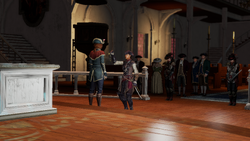
Aveline's "induction" into the Order
Meanwhile, the Templars under Madeleine de L'Isle had set up a working colony in Chichen Itza, and ensured the installation of their puppet Jean-Jacques Blaise d'Abbadie as Governor of Louisiana. The Mentor Agaté, Mackandal's former pupil, employed Madeleine's stepdaughter and Assassin Aveline de Grandpré with his assassination in 1765, and the next year with the murder of Baptiste, Agaté's former Brother and a Templar ally. In 1769 Aveline disrupted the Chichen Itza colony's operations by killing Rafael Joaquín de Ferrer, and visited the colony again in 1772, recovering two havels of a Prophecy Disk ahead of the Templars. In 1777, Madeleine was forced to reveal her Templar identity to her stepdaughter, who then pretended to join the Templars in order only to kill her during the feigned initiation.[26]
American Revolution
- Ratonhnhaké:ton:“Freedom IS peace.”
- Haytham Kenway:“Oh, no. It's an invitation to chaos. Only look at this little revolution your friends have started. I have stood before the Continental Congress and listened to them stamp and shout. All in the name of liberty. But it is just noise.”
- ―Ratonhnhaké:ton and his father Haytham Kenway, 1778.[来源]

Charles Lee igniting the Boston Massacre
At the onset of the American Revolution, the Colonial Rite of Templars saw an opportunity to create a Templar nation independent of the British Empire in the Thirteen Colonies. During the culmination of several fights between Boston natives and British soldiers on 5 March 1770, Haytham Kenway orchestrated a violent provocation by having his right-hand Charles Lee fire a shot, resulting in the Boston Massacre. This was the first time the Colonial Templars again faced opposition from the Colonial Assassin Brotherhood, when the exiled Mentor Achilles Davenport's protegé Ratonhnhaké:ton, the son of Haytham and Kaniehtí:io, unsuccessfully attempted to stop the Templars' scheme.[25]
On 16 December 1773, the Colonial Templars' financial operations were disrupted when Ratonhnhaké:ton and members of the Sons of Liberty movement dumped William Johnson's tea from the East India Company into the Boston harbor. Johnson was subsequently killed by Ratonhnhaké:ton in 1774 when trying to buy land from the Iroquois Confederacy. As the revolution began to formally erupt, the Templars sought to install Lee as the Commander of the Continental Army; however, Lawrence Washington's brother George was instead chosen at the Second Continental Congress. When the first battles of the American Revolutionary War were fought, the Templars were again struck a major blow when John Pitcairn, a British marine officer, was killed at the Battle of Bunker Hill.[25]
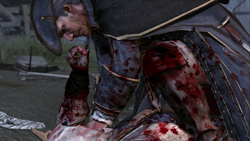
Haytham's death at his son's hands
After discovering Ratonhnhaké:ton was his son, Haytham Kenway chose to join forces with him in 1778 to find and kill the Templar turncoat Benjamin Church,[25] to Lee's dissatisfaction.[24] Their alliance ended when Haytham revealed that Washington was behind the Ratonhnhaké:ton's village in 1760, as his son believed that he had known the information for far longer. Haytham then returned to his residence at the Templars' headquarters in Fort George, New York, which was in 1781 besieged by Ratonhnhaké:ton with aid from the French Navy.[25] Seeking to protect Lee, Haytham entrusted him with the Grand Temple's key and stayed behind and fend off his son's attack. Despite his hopes of reconciliation,[24] Haytham was killed in the ensuing battle with his son, and Lee became the next Grand Master.[25]
While speaking at Haytham's funeral, the procession was disrupted by Ratonhnhaké:ton, seeking a confrontation with Lee. Lee had the Assassin captured, and after the Grand Master left, Ratonhnhaké:ton eliminated out his captors. Afraid the Assassin might take his life, Lee attempted to flee the country, but Ratonhnhaké:ton tracked him down to the Boston harbor. After their confrontation left them both heavily wounded, Lee fled to a tavern in Monmouth, where he shared one final moment with Ratonhnhaké:ton and perished at his hand,[25] leaving Shay Cormac as the last member of the Colonial Rite.[14]
French Revolution
- “For centuries we've focused our attentions on the trappings of power: the titles of nobility, the offices of Church and State. [...] When our brother Templars see the old institutions crumble, they will adapt. They will retreat to the shadows and we will, at last, be the Secret Masters we were meant to be.”
- ―François-Thomas Germain about the Templar Order, 1794.[来源]
By the late 18th century, the Templars in Paris, under the leadership of François de la Serre, had built up a steady relationship with King Louis XVI and the Assassins under the leadership of the comte de Mirabeau. A member of the order, the Sage François-Thomas Germain, began suffering from strange visions of the time of the First Civilization, and later found the Codex Pater Intellectus in Jacques de Molay's vault. Feeling a connection to de Molay through their Sage genetics, Germain was inspired to reshape the Templar Order in his vision, by removing the power of the aristocracy and the church and distributing it to the middle class, but was cast out by de la Serre for his radical ideas circa 1778.[10]
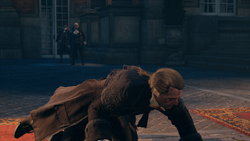
A dying François de la Serre with his attackers in hiding
Germain secretly managed to gain the support of other members of the Order, and orchestrated the Grand Master's assassination at the Palace of Versailles on 5 May 1778. Now effectively the new Grand Master, Germain continued to face opposition from the conservative Templars Élise and Chrétien Lafrenière. Germain was imprisoned within his own workshop by Lafrenière, where he was rescued by the unwitting Assassin Arno Dorian, seeking revenge for the murder of his adoptive father, the old Grand Master. Germain convinced Arno that Lafrenière was the perpetrator, and Lafrenière's subsequent death destroyed much of the opposition.[10]
Per Germain's plan, the French population began to rise up, fueled by inflation of grain prices by Marie Lévesque. Eventually, the Templar Louis-Michel le Peletier cast the final vote that condemned King Louis to death at the National Convention. On 21 January 1793, the Grand Master attended the King's execution by guillotine at the Place de la Révolution, and later entrusted control of the new French Republic to the Templar Maximilien de Robespierre, a leading figure in the radical Jacobin Club. Robespierre proceeded to enforce Templar rule through the Reign of Terror, resulting in the execution by guillotine or imprisonment of thousands of citizens.[10]
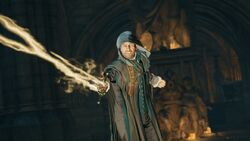
Grand Master Germain using the Sword of Eden in the Temple
At the Festival of the Supreme Being on 8 June 1794, held by Robespierre, Arno Dorian and Élise de la Serre managed to turn public opinion against Robespierre, and Germain abandoned him. After escaping from the National Guard on 27 July, Robespierre fled to his Jacobin supporters, but was forced to give the location of the Templar headquarters at the Temple.[10]
Arno and Élise infiltrated the Temple, where they confronted Germain in Jacques de Molay's vault. Managing a final stand utilizing de Molay's Sword of Eden, Germain killed Élise, but in turn lost his life at the hands of Arno, leaving the French Templars leaderless. Nonetheless, Germain was convinced that his Templar brothers would embrace his vision for the Order.[10]
Early modern era
Rule over Lower Canada
- “Our historic assembly will be held on Saint John's Day— a date the Oppressors value so much! How ironic.”
- ―Edmund Bailey O'Callaghan, about Duvernay's soirée, 1834.[来源]
During the early 19th century, British Templars operated as the Château Clique, a group of wealthy families in Lower Canada, which held control over the administration of Quebec. In response, the Assassins, fighting for French Canadian independence from the Templars' oppression, financed the journalist Ludger Duvernay in 1832 to write several articles accusing the administration of serving the Clique.[13]
The Templars had Duvernay arrested, and hired vagrants and laborers to mob the jail in protest of the journalist's writings. The Assassins managed to turn the populace against the Templars, likely with the usage of an Apple of Eden. The Brotherhood secured Duvernay's release, and in 1834, he founded the Société Aide-toi et le ciel t'aidera.[13] On 24 June of that year, Duvernay held a soirée for the society to stand up against the "Oppressors", which the Templars attempted to disrupt.[27]
Conquest of India
- “You're one of a kind. Benevolent, they say. All castes and creeds under one roof. You haven't even the temper to order the death of one lowly thief. It takes more nerve than that to bring the world to order.”
- ―General Francis Cotton to Maharaja Ranjit Singh, 1839.[来源]
By 1839, the British Templars had turned their attention towards India, hoping to gain control of the region through Great Britain's conquests. In 1839, the Sikh Empire remained the last bastion of resistance to the British Empire in the Indian subcontinent. Seeing an opportunity to take control of India under the banner of the British banner, the Templars focused on removing Maharaja Ranjit Singh from power,[1] and taking the Koh-i-Noor, a powerful Piece of Eden, from his possession.[28]
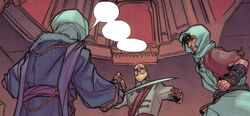
Cotton facing Singh after poisoning his tea
On 27 June 1839, William Hay Macnaghten and his companion, General Francis Cotton, a Templar, attended a feast at the Maharaja's summer palace, secretly intending to poison him in order to weaken the Sikh Empire's power. During their meeting with the Maharaja that evening, Cotton poisoned his tea, which would later kill him, but faced opposition from the Assassin Arbaaz Mir. In the following conflict, Princess Pyara Kaur activated the Koh-i-Noor and temporarily transformed into the Precursor Durga. After Cotton shot at her, Durga unleased a burst of energy, killing Cotton and the palace guards.[28]
Two years later, Cotton's successor, administrator William Sleeman, a Master Templar, and his right hand Alexander Burnes kidnapped the Mentor Hamid and stole the Koh-i-Noor. Sleeman took the artifact and a Precursor box into the Precursor temple in Amritsar, where the artifacts showed him a map leading to another temple in Herat. Sleeman and Burnes journeyed there, but were instead distracted by Arbaaz Mir, who had followed the Templars to Afghanistan.[29]
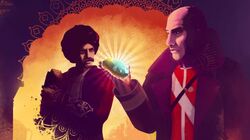
Sleeman and Burnes with the artifacts
Though the Assassin was captured, he later escaped, but opted to let Burnes live after deating him in a duel and retaking the artifacts. Sleeman had journeyed back to Amritsar to kidnap Mir's lover Pyara Kaur to exchange her for the artifact, holding her ransom inside the summer palace. The Assassin confronted Sleeman and handed over the artifacts, though the princess stabbed swiftly stabbed Sleeman, allowing Mir to retake the Koh-i-Noor, leaving the Templars with only the Precursor box.[29]
Several years later, the Templar plan to weaken the Sikh Empire was a success, and control of the region ultimately fell to the Templars, under the British banner, after the empire's downfall in 1849.[28]
Industrial Revolution
- “This tea was brought to me from India by a ship, then, up from the harbor to a factory, where it was packaged and ferried by carriage to my door, unpacked in the larder and brought upstairs to me. All by men and women who work for me. Who are indebted to me, Crawford Starrick, for their jobs, their time, the very lives they lead. They will work in my factories and so too shall their children.”
- ―Crawford Starrick talking about his influence in London, 1868.[来源]

Starrick conversing with his subordinates
Since the death of Edward Kenway in 1735, the British Templars dominated over London, the capital of the British Empire. As a result, the Templars' influence over the Empire was unmatched by the Assassins, and the Templars took a leading role in steering the Industrial Revolution. By the mid 1860s, the British Templars had fallen under the leadership of Grand Master Crawford Starrick, a London businessmen with influence over every aspect of London society, and was at the head of a criminal gang known as the Blighters.[30]
By 1868, the British Templars had learned of an artifact hidden in London, a Shroud of Eden. While Starrick retained his control over the city, he and Lucy Thorne endeavoured to find the artifact's location. Around the same time, two young twin Assassins, Jacob and Evie Frye, journeyed to the city to retake it from Templar control, with the aid of local Assassin Jayadeep Mir and a network of connections through the city.[30]
Over the course of several months, Starrick saw his network of lieutenants eliminated, as the Assassins eliminated Rupert Ferris, David Brewster, John Elliotson, Malcolm Millner, Pearl Attaway, Philip Twopenny, James Brudenell and Maxwell Roth. The Templars' attempt on the life of Prime Minister Benjamin Disraeli, who opposed their interests, was also thwarted, while the Blighters also lost their territory to the Assassins' gang, the Rooks. Their search for the Piece of Eden was also severely hindered after Evie eliminated Thorne and was able to secure a First Civilization key.[30]

Starrick wearing the Shroud of Eden
With his power severely dwindled, Starrick made a last endeavour to oppose the Assassins, by planning to kill Queen Victoria and other high profile guests at a party at Buckingham Palace. Having discovered the artifact was located in a vault beneath the palace, Starrick stole the key from Evie and obtained the artifact while the Assassins were busy taking down the Grand Master's agents at the party.[30]
Ultimately, though, the Shroud was unable to prevent Starrick's death at the hands of the Assassins during their subsequent confrontation, and Templar control over the British Empire temporarily ceased.[30]
Revolutionary Russia
- “Russia has made some very powerful friends. She will be a new Eden on Earth.”
- ―Tsar Alexander III of Russia on his alliance with the Templars, 1888.[来源]
By the late 19th century, the Templars managed to hold sway over Russia through their influence over Tsar Alexander II, until his death on 13 March 1881 during a bomb attack by the Narodnaya Volya, a front for the Russian Assassins. His son and successor, Alexander III, became a willing ally of the Templars and was entrusted with a Staff of Eden, which became the Imperial Scepter.[31]
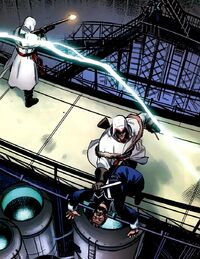
Nikolai killing Templar researchers in Tunguska
On 29 October 1888, Tsar Alexander III was confronted by the Assassin Nikolai Orelov while travelling by train to Saint Petersburg, and Alexander was stabbed in the kidney during their fight, which resulted in the Borki train disaster. Alexander died of kidney failure in 1894, and was succeeded by his son Nicholas II.[31] In order to continue holding influence over the Russian Imperial court, the Templar agent Grigori Rasputin grew close to the Imperial family, and retrieved the Imperial Scepter,[4] taking it to a Templar research facility in Tunguska.[31]
On 30 June 1908, the Assassins raided the facility, and their ally Nikola Tesla unleashed a burst of electricity to the facility, destroying the artifact and resulting in a huge explosion. Rasputin retrieved a splinter of the artifact, which he utilized to continue holding sway among the Romanov family,[31] until he was killed by the Assassins in 1916. The Assassins eventually managed to help the rise of the Soviet Union after the Russian Revolution.[1]
World War I
- “We may have struck a blow against the enemy, but London is still riddled with German agents. Currently, there's a new group, unlike anything I've seen before. Theirs is a fanatical, almost religious, fervor.”
- ―Winston Churchill to Lydia Frye about the Master Spy's network, 1916.[来源]
In 1914, the First World War broke out, pitting the Allied Powers and Central Powers against one another. Throughout the war, the Templars' presence was strong within the ranks of the German Empire, using their forces as a means to further their plans.[30] Throughout the war, the Templars and Assassins continued opposing each other's plans. To that extent, on 29 December 1914, during the Christmas truce, the German Templar general Erich Albert was assassinated by an Assassin operating as a medic in the British Army.[27]
In 1916, a group of Templars started operating a spy network in London, England. The network, led by the Master Spy, a Sage secretly serving the interests of Juno as her Instrument, spread its influence through the Tower Bridge area. On orders of Winston Churchill, the Assassin Lydia Frye killed the members of the network and the Master Spy.[30]
Russian Revolution
- Templar #1:“Sverdlov already had the Tsar and his wife killed. The kids are next, if they don't talk.”
- Templar #2:“The Tsar is dead? I need to see that.”
- ―Two Templars discussing their involvement in the shooting of the Romanov family, 1918.[来源]
Near the end of the First World War, the Bolsheviks' communist movement in Russia led to the Russian Revolution in February and October 1917. While the Templars opposed communism, the Assassins supported the working class in installing a populist government and pressured Tsar Nicholas II to abdicate.[1]

A Templar officer giving orders outside Ipatiev House in Yekaterinburg
In 1918, the Russian Templars discovered that the royal family was in possession of a Precursor box, and on 17 July they infiltrated their Ipatiev House in Yekaterinburg. A Templar team led by Yakov Yurovsky massacred the entire royal family, except the Tsarevich's daughter Anastasia Nikolaevna, who escaped with the artifact and the help of Nikolai Orelov.[32]
The Templars were contacted by Leon Trotsky, a friend of Nikolai's who intended to hand Anastasia over to the Templars for the sake of the Revolution. Amidst the Kazan Operation, Trotsky betrayed Nikolai when he arrived seeking aid. Though the Templars managed to capture Nikolai, he was saved by Anastasia who had acquired the consciousness of Shao Jun through interaction with the Precursor box.[32]
Ten years later, with Russia now transformed into the communist Soviet Union, the Templars had managed to work their way into the government led by Joseph Stalin by infiltrating the Politburo. The Templar Yuri Petrovich Figatner started a counter-revolutionary commission to root out the Assassin presence in the Soviet Union, a plot which would ensure the Templars held the upper hand over the Assassins in Russia until 1953, when Stalin was killed by the Assassins.[15]
Chinese Civil War
- “If [the Nine] want to come here and see all the squabbling nation-states we have to deal with, the warlords in the countryside, the communists and gangsters in the back alleys... let them see how bloody easy it is to keep order in this cesspool, I say!”
- ―Coxworth about the state of Shanghai and China, 1925.[来源]
In the early 20th century, the Chinese Templars were led by Grand Master Sun Yat-sen, the Provinsial President of the Republic of China. Under his leadership, he managed to maintain good relations with the communists, preserving the peace between them and the nationalists in Shanghai. In 1925, Sun was killed by the Assassin Brotherhood and Stirling Fessenden became the new Grand Master. However, the Shanghai Rite was looking to induct Sun's successor Chiang Kai-shek into the Order and grant him the position of Grand Master.[33]
As Chiang was more opposed to communism than Sun, tensions between Chiang's Nationalist Party and the Communist Party rose in Shanghai. Around the same time, Grand Master Thaddeus Gift of the British Rite was killed by the Black Cross Albert Bolden for corruption. To make up for his father's mistakes, Darius Gift was sent to Shanghai to deliver a box which contained, unbeknownst to him, the severed finger of his father wearing a Templar ring.[33]
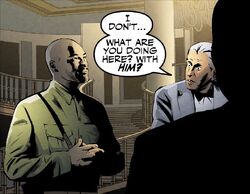
Fessenden meeting with Chiang Kai-shek
After eliminating the traitor Yuri Dolinsky, who planned to use the Templar train Great Wall against the Templars,[34] the Black Cross rescued Darius Gift after he lost the box and was harassed by corrupt policemen. While Gift endeavoured to receive the box, the Black Cross sought to discover who betrayed Gift's location. Gift retrieved the box from Ruan Lingyu, and the Black Cross became entangled in a conflict with underworld boss Du Yuesheng and his Green Gang.[33]
The Black Cross discovered that Chiang Kai-shek betrayed the Templars, having no interest to accept their invitation and instead allying himself with Du Yuesheng against the communists. After Gift discovered it was the Black Cross who killed his father, Gift shot his fellow Templar, believing his subsequent fall from a rooftop to have killed him.[33]
Spanish Civil War
- “Few people can survive direct contact with the Koh-i-Noor. Fewer still can control it. If I were to hazard a guess, I'd say [Grosvenor] plans to control you in order to control the gem.”
- ―Albert Bolden to Ignacio Cardona, 1937.[来源]
Around 1936, the Templar Rufus Grosvenor, a former disciple of the Master Spy and secretly an Instrument of Juno, stole the Koh-i-Noor from the Black Cross Albert Bolden. As his former master did research into bloodlines with high concentrations of Precursor DNA, Grosvenor decided to locate the Assassin Ignacio Cardona, who was involved in the Spanish Civil War, and have him unlock the artifact's secrets. Meanwhile, Bolden followed Grosvenor to Spain, hoping to keep the artifact safe.[35]
A master manipulator, Grosvenor persuaded the Assassin Norbert Clarke, a British Assassin sent to aid the Spanish Brotherhood, into taking his own life and the Templar stole his identity, working his way into Cardona's Assassin cell in Barcelona. After internal fighting broke out between the Republicans and communists and the Assassins were unsure of who to join, Grosvenor convinced Cardona to use the Koh-i-Noor to calm them; however, the Assassin dropped swiftly dropped the artifact. Bolden, watching the affair, attacked Grosvenor and escaped with an unconscious Cardona.[35]
Convincing Cardona of Grosvenor's identity and intentions, the Assassin joined Bolden to take the artifact from Grosvenor. However, Grosvenor had persuaded the other Assassins to his cause, leading to an eventual confrontation in a run-down church in the countryside. Grosvenor granted a defeated Cardona another opportunity to unlock the artifact's power, and the Assassin created bulls from its energy to destroy the church, causing the rogue Assassin to flee and leaving the artifact buried. After Bolden and Cardona continued fighting in the civil war, Bolden served as the protector of the site.[35]
World War II
- “H. has [the Apple of Eden], so I assume the war will begin as soon as he can take over. We'll let him have his fun (Lord knows, that kind of purge will be good for Europe) and then end it with a bang, as planned. Out of the chaos of war a new order will emerge!”
- ―Henry Ford in a letter to Thomas Edison, 1930s.[来源]
During the 1930s, Henry Ford, one of the Order's leaders, shipped one of the Templars' Apples of Eden to Germany to pass it onto Adolf Hitler, who would go on to become the leader of Nazi Germany. Having already laid the groundworks for the Second World War, several of the Order's most influential businessmen founded Abstergo Industries as its public front in 1937. Their intention for the company was to act as a global conglomerate secretly dominating the capitalist market in the wake of the war, and to dismantle communist governments.[20]
In 1939, Hitler used his Apple of Eden to ignite the Second World War. Alongside Hitler, the war's other most prominent leaders – Franklin D. Roosevelt, Winston Churchill and Joseph Stalin – were all secretly manipulated by the Templars into creating a worldwide state of chaos and disorder to allow the Order to take control.[4]
At the start of the war, Obbergruppenführer Gero Kramer, a high-ranking Templar, started a secret project called Die Glocke, a device that would later be developed into the Animus, using the German nuclear project to disguise his true intentions. Kramer swiftly dealt with Assassin infiltrators sent by Boris Pash, and employed the aid of Nikola Tesla and the Nazis' Apple of Eden to build the device.[36]
On 27 February 1943, the Assassin Eddie Gorm infiltrated the Nazi heavy water facility in Vemork, where Die Glocke was secretly located. Eventually confronted by Kramer, the Templar overpowered the Assassin easily and placed him inside the Animus, intending for him to relive the lives of his ancestors to find more Pieces of Eden, ensuring Kramer would take a leading role in creating their New World Order. However, Gorm's consciousness transferred to his grandson Maxime, who was reliving Eddie's memories simultaneously in 2016.[36]
In July 1944, at the height of the war, economic agents of the Templars met at the Bretton Woods conference to launch the next phase of the Plan, and the World Bank was subsequently established.[20] On 30 April 1945, as Hitler left the Führerbunker to rendezvous with Churchill, he was killed by the Assassins. Two months later, Abstergo sanctioned the Manhattan Project's tests of the atomic bomb, and on 6 and 9 August of that year two atomic bombs were dropped on Japan.[4] Amidst the resulting chaos of the war, the Templars were able to guide the world's economic rebuilding towards the goals of their New World Order.[20]
Reshaping the world
- “Democracy must die to ensure the stability of the world. Capitalism will end it. [...] The capitalists will do whatever we tell them to. We print the dollars they worship after all.”
- ―An unknown Templar regarding their plans to dismantle democracy.[来源]
Following the war, one of the Templars' first acts was orchestrating the assassination of Mahatma Gandhi, who had risen up against the British rule in India using an Apple of Eden, in 1948.[4] Several months later, Harry Dexter White was killed by his fellow Templars, after he decided to betray them and tried to reveal their capitalist plans to the Soviet Union.[20]
The Chinese Civil War continued after the end of World War II, and the Templars inevitably decided to exert their influence over Chiang Kai-shek's communist rival Mao Zedong, who became the new leader of China.[20] Meanwhile, the Templars' grip on the Soviet Union had weakened, culminating in the fatal poisoning of Joseph Stalin at the hands of the Assassins in 1953.[15]
That same year Abstergo planned the overthrow of Prime Minister Mohammad Mosaddegh of Iran to prevent the nationalization of the country's oil industry. In June 1954 the Templars again killed one of their own members, Alan Turing, for disobeying their order to not build a robot to prevent mass unemployment and lower birth rates, and they also overthrew the communist President of Guatemala, Jacobo Árbenz.[20]
The following decade, President John F. Kennedy of the United States was killed by the Templar sleeper agent Lee Harvey Oswald to prevent the Americans' joint venture to the Moon with the Soviet Union. This paved the way for NASA, one of Abstergo's puppet companies, to organize the Apollo 11 spaceflight and retrieve an Apple of Eden from the Moon's surface.[4]
Five years following the coup d'état in Chile was saw the death of communist President Salvador Allende in 1973,[20] Abstergo scientist Warren Vidic created the first version of Animus, a device capable of reading the genetic memory of its user.[23] The Animus Project, aimed at discovering information about Pieces of Eden and the Assassins through genetic memory, was formally started in 1980.[15] As part of this project, Abstergo kidnapped a young boy – later named Daniel Cross – in 1983 to use him as its fourth subject,[31] and Vidic experimented on the boy's mind using a Piece of Eden replica[20] to implant an impulse to kill the Mentor of the Assassin Brotherhood. He was subsequently released into the world as an unwitting sleeper agent sent to infiltrate the Assassins.[31]
In 1991, Abstergo took a leading role in the overthrow of President Mikhail Gorbachev of the Soviet Union after realizing he did not have Abstergo's interests at heart. The Templars orchestrated the downfall of the Soviet Union and installed their puppet Boris Yeltsin as the first President of Russia. Nine years later, they helped Vladimir Putin gain power and become his successor.[20]
Contemporary era
The Great Purge
- “We have turned over a rock and sent the insects scurrying, but we will stamp on them before they can hide again. I am confident that we will soon witness the fall of the Order of Assassins, and we may fullfill our ambitions unimpeded.”
- ―Dr. Warren Vidic in an email to Alan Rikkin, 2000.[来源]
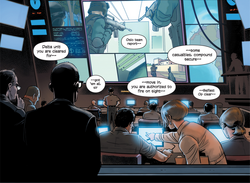
The Templars overseeing the Great Purge
By 2000, Daniel Cross had become an official member of the Assassin Brotherhood, believing it to be his goal to find their Mentor after experiencing a vision in 1998. After travelling the world to gain support from the other Assassins in his quest, the Mentor met Daniel at his office in Dubai on 6 November 2000. Acting on the impulse in his brain, Daniel killed the Mentor when the latter handed him a ceremonial hidden blade.[31]
The Assassins were left in a state of chaos,[31] which allowed to the Templars to gain the upper hand in the American Presidential election the next day and install their puppet George W. Bush.[20] On 21 November, Daniel returned to Abstergo's Philadelphia facility and gave them the locations of the Assassin safehouses he visited, after which the Templars initiated the Great Purge – a woldwide operation that resulted in the near-annihiliation of the Assassin Brotherhood.[31]
The Templars spent the next several years routing out the remaining Assassin cells and safehouses. In 2002, Daniel recovered the Prophet's Codex, a book written by Ezio Auditore da Firenze, from a hidden library beneath Moscow, and first learned of the Assassin's descendant "Desmond".[37]
The Animus Project
- “We've found a perfect candidate named Desmond Miles. His ancestral tree fits the data gathered from Subject 16's memory of Ezio Auditore. But it is quite likely that he won't cede essential details freely. Desmond is the key to the location of the Pieces of Eden. Our scientists have been running tests. If we were to place just one within a satellite and angle it toward the Earth... well, utopia would be within our grasp.”
- ―Dr. Warren Vidic about the Animus Project's intent, 2012.[来源]

A sketch of Eye-Abstergo in orbit
Meanwhile, Vidic continued the Animus Project, uncovering new information about the Pieces of Eden for their Eye-Abstergo, a satellite powered by a Piece of Eden meant to enforce their New World Order, set for launch in 2012.[20] In 2005, the Assassins sent Lucy Stillman to infiltrate Abstergo as a new employee and gain insight into the Animus Project,[7] though she was eventually turned by the Templars.[38]
The Assassin Clay Kaczmarek allowed himself to be captured for the Animus Project on the orders of their leader William Miles in 2011, and through reviewing his genetic memories, Vidic discovered a lead on Ezio Auditore da Firenze's Apple of Eden. Clay killed himself in 2012, after Lucy's new allegiance prevented her from allowing him to escape,[38] the Templars sought out and kidnapped Desmond Miles as the new subject for their project.[15] Eventually, the Templars allowed Desmond to escape to the Assassins with Lucy, to encourage his willingness at finding Ezio's Apple of Eden.[38] However, when they recovered the artifact from the Colosseum Vault, the Precursor Juno forced Desmond to kill Lucy[20] to prevent the Templars from obtaining the artifact and finding the Assassins.[25]

Desmond using the Apple of Eden in the Abstergo Campus
Meanwhile, the Assassins engaged in several altercations with Templar teams led by Daniel Cross and their new agent Juhani Otso Berg.[15] Desmond's Assassin team had taken shelter inside the Grand Temple, and began looking for power sources to activate the ancient temple.[25]
Their search ultimately resulted in William Miles' capture by Berg's Sigma Team.[15] During the exchange at the Abstergo Campus in Rome to trade William for the Apple, his son Desmond killed Daniel Cross and instead used the artifact to kill Vidic and the guards. The Eye-Abstergo project was postponed indefinitely in light of Vidic's death.[25]
Phoenix Project
- “Using Animus technology, Precursor history will be open to us for the first time ever. Ancient languages will be unlocked and ancient technology will be ours for the taking. Imagine what will be possible if we master the technology underpins the Pieces of Eden. Such discoveries would surpass one-hundredfold the splitting of the atom.”
- ―Narration of Abstergo Industries' internal Phoenix Project video, 2014.[来源]
On 21 December 2012, Desmond Miles sacrificed himself in the Grand Temple in order to save the world from destruction by a:n incoming solar flare.[25] Several hours after his death, Abstergo agents recovered his body from the temple;[15] utilizing the DNA from his genetic memories, his genetic sample became the basis for Abstergo Entertainment's Sample 17 Project, aimed at exploring Desmond's rich ancestry. By 2013, Abstergo had released the Animus as a consumer product as the Animus glass,[23] and in India as the Brahman V.R., which would automatically upload a user's genetic memory to the Abstergo Cloud.[28]
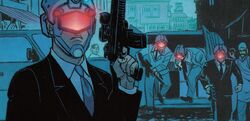
Abstergo agents in Mumbai
In November 2013, the Sample 17 Project was sabotaged by one of their employees, the Sage John Standish, who was ultimately killed by Abstergo guards following an altercation between Standish and another employee.[23] Simulatenously, Juhani Otso Berg was dispatched to India to find Jot Soora, presumably the descendant of Arbaaz Mir after following a lead from the Brahman project, hoping to secure the Koh-i-Noor diamond. However, the Assassin's true descendant Monima Das, Jot's fiancée, was killed during the Abstergo agents' pursuit of Jot Soora and his Assassin captors, and Arbaaz's memories were wiped from the Abstergo Cloud.[28]
The recovery of John Standish's body greatly helped Abstergo's Phoenix Project, aiming to sequence a full First Civilization triple-helix genome with the ultimate goal of unlocking the secrets of the Pieces of Eden.[23] Abstergo agents and Assassin cells continued their renewed search for the ancient artifacts, resulting in the Assassins' failed attempt to secure the Precursor box from an Abstergo facility in Rotterdam, Juhani Otso Berg's fruitless search for the Ankh in Germany, and his excavation of the remains of the Observatory in Jamaica. In October, the Assassins on the Altair II under Assassin leader Gavin Banks destroyed the Abstergo facility holding John Standish's body in Paris,[14] and Abstergo started looking for the remains of a new Sage.[10]
See also
References
- ↑ 1.00 1.01 1.02 1.03 1.04 1.05 1.06 1.07 1.08 1.09 1.10 1.11 Assassin's Creed Encyclopedia
- ↑ Assassin's Creed: Origins
- ↑ Assassin's Creed: Origins – The Curse of the Pharaohs
- ↑ 4.00 4.01 4.02 4.03 4.04 4.05 4.06 4.07 4.08 4.09 4.10 4.11 4.12 4.13 4.14 Assassin's Creed II
- ↑ 5.0 5.1 5.2 5.3 5.4 5.5 5.6 5.7 Assassin's Creed: Revelations
- ↑ Assassin's Creed: Altaïr's Chronicles
- ↑ 7.0 7.1 7.2 7.3 Assassin's Creed
- ↑ 8.0 8.1 8.2 8.3 8.4 Assassin's Creed: Memories
- ↑ 9.0 9.1 Assassin's Creed 4: Hawk
- ↑ 10.0 10.1 10.2 10.3 10.4 10.5 10.6 10.7 Assassin's Creed: Unity
- ↑ Assassin's Creed 5: El Cakr
- ↑ Assassin's Creed 6: Leila
- ↑ 13.0 13.1 13.2 13.3 Assassin's Creed: Revelations – Discover Your Legacy
- ↑ 14.0 14.1 14.2 14.3 14.4 14.5 14.6 14.7 Assassin's Creed: Rogue
- ↑ 15.0 15.1 15.2 15.3 15.4 15.5 15.6 15.7 Assassin's Creed: Initiates
- ↑ Assassin's Creed: Lineage
- ↑ 17.0 17.1 17.2 Assassin's Creed: Recollection
- ↑ Assassin's Creed: Renaissance
- ↑ Assassin's Creed II: Discovery
- ↑ 20.00 20.01 20.02 20.03 20.04 20.05 20.06 20.07 20.08 20.09 20.10 20.11 20.12 20.13 20.14 20.15 Assassin's Creed: Brotherhood
- ↑ Assassin's Creed: Brotherhood novel
- ↑ 22.0 22.1 22.2 Assassin's Creed Chronicles: China
- ↑ 23.0 23.1 23.2 23.3 23.4 Assassin's Creed IV: Black Flag
- ↑ 24.0 24.1 24.2 24.3 Assassin's Creed: Forsaken
- ↑ 25.00 25.01 25.02 25.03 25.04 25.05 25.06 25.07 25.08 25.09 25.10 25.11 Assassin's Creed III
- ↑ Assassin's Creed III: Liberation
- ↑ 27.0 27.1 Assassin's Creed: Project Legacy
- ↑ 28.0 28.1 28.2 28.3 28.4 Assassin's Creed: Brahman
- ↑ 29.0 29.1 Assassin's Creed Chronicles: India
- ↑ 30.0 30.1 30.2 30.3 30.4 30.5 30.6 Assassin's Creed: Syndicate
- ↑ 31.0 31.1 31.2 31.3 31.4 31.5 31.6 31.7 31.8 Assassin's Creed: The Fall
- ↑ 32.0 32.1 Assassin's Creed Chronicles: Russia
- ↑ 33.0 33.1 33.2 33.3 Assassin's Creed: Templars – Volume 1: Black Cross
- ↑ Assassin's Creed: Great Wall
- ↑ 35.0 35.1 35.2 Assassin's Creed: Uprising – Volume 2
- ↑ 36.0 36.1 Assassin's Creed: Conspiracies
- ↑ Assassin's Creed: The Chain
- ↑ 38.0 38.1 38.2 Assassin's Creed: Revelations – The Lost Archive
| ||||||||||||||||||||||||||||||||||||||||||||||||||||||||||




